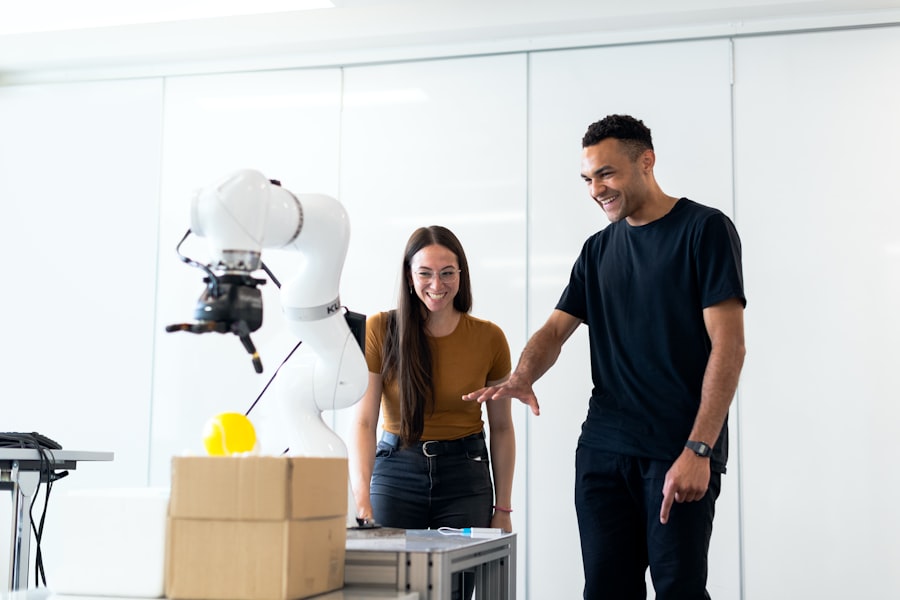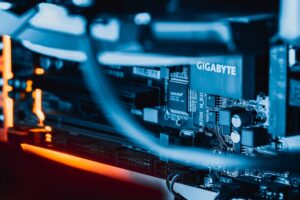Robotics is a multidisciplinary field that combines elements of engineering, computer science, and cognitive psychology to design, construct, and operate robots. These machines are capable of performing tasks autonomously or semi-autonomously, often mimicking human actions or enhancing human capabilities. The roots of robotics can be traced back to ancient history, with myths and legends featuring mechanical beings.
However, the modern era of robotics began in the mid-20th century, marked by the development of programmable machines and the advent of artificial intelligence. Today, robotics encompasses a wide range of applications, from industrial automation to personal assistants, and continues to evolve at a rapid pace. The significance of robotics in contemporary society cannot be overstated.
As technology advances, robots are increasingly integrated into various sectors, enhancing productivity and efficiency while also raising questions about their implications for the workforce and society at large. The exploration of robotics is not merely a technical endeavor; it also invites philosophical inquiries about the nature of work, the definition of intelligence, and the ethical considerations surrounding autonomous systems. As we delve deeper into the world of robotics, it becomes essential to understand both the technological advancements driving this field and the broader societal impacts that accompany them.
Key Takeaways
- Robotics is the branch of technology that deals with the design, construction, operation, and use of robots.
- Advancements in robotics technology have led to the development of more sophisticated and versatile robots, capable of performing a wide range of tasks.
- Robotics has had a significant impact on various industries, including manufacturing, healthcare, agriculture, and transportation, by increasing efficiency and productivity.
- The ethical and social implications of robotics include concerns about job displacement, privacy, and the potential for misuse of autonomous robots.
- Artificial intelligence plays a crucial role in robotics by enabling robots to learn, adapt, and make decisions based on their environment and tasks.
Advancements in Robotics Technology
The past few decades have witnessed remarkable advancements in robotics technology, driven by innovations in materials science, sensor technology, and artificial intelligence. One notable development is the emergence of soft robotics, which utilizes flexible materials to create robots that can adapt to their environments. Unlike traditional rigid robots, soft robots can navigate complex terrains and interact safely with humans.
For instance, researchers have developed soft robotic grippers that can handle delicate objects without causing damage, making them ideal for applications in fields such as agriculture and healthcare. Another significant advancement is the integration of machine learning algorithms into robotic systems. These algorithms enable robots to learn from their experiences and improve their performance over time.
For example, autonomous vehicles utilize deep learning techniques to recognize objects and make real-time decisions based on their surroundings. Companies like Waymo and Tesla are at the forefront of this technology, continuously refining their systems through vast amounts of data collected from real-world driving scenarios. This capability not only enhances the safety and reliability of autonomous systems but also opens up new possibilities for their application across various domains.
Impact of Robotics on Various Industries

The impact of robotics on industries is profound and multifaceted.
For instance, automotive manufacturers like Toyota and Ford employ robotic arms for tasks such as welding and painting, which not only speeds up production but also improves precision and quality control. The use of collaborative robots, or cobots, has further transformed manufacturing by allowing human workers to work alongside machines safely, enhancing productivity without displacing jobs. In healthcare, robotics is making significant strides in surgical procedures and patient care.
Robotic surgical systems, such as the da Vinci Surgical System, allow surgeons to perform minimally invasive surgeries with enhanced precision and control. These systems provide surgeons with a 3D view of the surgical site and allow for greater dexterity than traditional methods. Additionally, robots are being used in rehabilitation settings to assist patients in regaining mobility after injuries or surgeries.
For example, exoskeletons are being developed to help individuals with spinal cord injuries walk again, showcasing the potential of robotics to improve quality of life.
Ethical and Social Implications of Robotics
| Metrics | Data |
|---|---|
| Ethical considerations | Risk of job displacement, privacy concerns, autonomous weapon systems |
| Social implications | Impact on healthcare, education, elderly care, and social interactions |
| Public perception | Trust in robotics, fear of automation, acceptance of robotic assistance |
| Regulatory framework | Laws and policies governing robotics, liability and accountability |
As robotics technology continues to advance, ethical and social implications become increasingly critical to address. One major concern is the potential displacement of jobs due to automation. While robots can enhance productivity and efficiency, they also pose a threat to traditional employment in various sectors.
For instance, in manufacturing and logistics, robots are capable of performing tasks that were once done by human workers, leading to fears of widespread unemployment. This raises important questions about how society will adapt to a future where machines may take over many roles traditionally held by humans. Moreover, the deployment of autonomous systems raises ethical dilemmas regarding decision-making in critical situations.
For example, self-driving cars must be programmed to make split-second decisions in scenarios where accidents are unavoidable. The ethical implications of these decisions—such as whether to prioritize the safety of passengers over pedestrians—are complex and require careful consideration. Policymakers and technologists must collaborate to establish guidelines that ensure responsible development and deployment of robotic systems while addressing public concerns about safety and accountability.
The Role of Artificial Intelligence in Robotics
Artificial intelligence (AI) plays a pivotal role in enhancing the capabilities of robotic systems. By incorporating AI algorithms, robots can process vast amounts of data from their environments, enabling them to make informed decisions autonomously. Machine learning techniques allow robots to recognize patterns and adapt their behavior based on previous experiences.
For instance, AI-powered drones can analyze aerial imagery to identify changes in land use or monitor environmental conditions, providing valuable insights for agriculture and conservation efforts. Natural language processing (NLP) is another area where AI significantly enhances robotics. Robots equipped with NLP capabilities can understand and respond to human language, facilitating more intuitive interactions between humans and machines.
Virtual assistants like Amazon’s Alexa or Apple’s Siri exemplify this integration, allowing users to control smart home devices or access information through voice commands. As AI continues to evolve, its integration into robotics will likely lead to more sophisticated human-robot interactions, making robots more accessible and useful in everyday life.
Future Trends and Predictions in Robotics

Looking ahead, several trends are poised to shape the future of robotics significantly. One prominent trend is the increasing focus on human-robot collaboration. As industries recognize the value of combining human creativity with robotic efficiency, collaborative robots will become more prevalent in workplaces.
These robots are designed to work alongside humans safely, enhancing productivity while allowing workers to focus on more complex tasks that require critical thinking and problem-solving skills. Another trend is the rise of autonomous systems in logistics and supply chain management. Companies like Amazon are investing heavily in robotic solutions for warehousing and delivery operations.
Automated guided vehicles (AGVs) are being deployed to transport goods within warehouses efficiently, while drones are being explored for last-mile delivery solutions. As these technologies mature, they will likely transform how goods are stored and delivered, leading to faster service and reduced operational costs.
The Integration of Robotics in Everyday Life
The integration of robotics into everyday life is becoming increasingly evident as technology advances and consumer acceptance grows. Home automation systems featuring robotic components are gaining popularity among consumers seeking convenience and efficiency. Robotic vacuum cleaners like Roomba have already made a significant impact on household chores by autonomously navigating spaces to clean floors without human intervention.
This trend is expected to expand further as more sophisticated home robots emerge that can perform a variety of tasks beyond cleaning. In addition to household applications, robotics is also making strides in personal assistance. Social robots designed for companionship or support are being developed for various demographics, including the elderly or individuals with disabilities.
These robots can provide reminders for medication schedules or engage users in conversation, helping combat loneliness and improve mental well-being. As society becomes more accustomed to interacting with robots in personal spaces, we may see an increase in their roles as companions or caregivers.
Challenges and Opportunities in the Future of Robotics
Despite the promising advancements in robotics technology, several challenges must be addressed for its full potential to be realized. One significant challenge is ensuring the safety and reliability of robotic systems in dynamic environments. As robots become more autonomous and integrated into daily life, they must be able to navigate complex situations without causing harm to humans or property.
Developing robust safety protocols and standards will be essential for fostering public trust in these technologies. On the other hand, opportunities abound for innovation within the field of robotics. The ongoing research into bio-inspired robotics—where engineers draw inspiration from nature—holds great promise for creating more efficient and adaptable machines.
For example, researchers are studying how animals move through their environments to design robots that can traverse challenging terrains more effectively than traditional wheeled or tracked vehicles.
By bringing together experts from various fields—engineering, ethics, sociology—innovative solutions can be developed that not only advance technology but also consider its broader implications for society.
As we navigate this rapidly evolving landscape, embracing both the challenges and opportunities presented by robotics will be essential for shaping a future where humans and machines coexist harmoniously.
If you are interested in the intersection of robotics and biology, you may find the article Exploring Algae: Ecology, Distribution, and Thallus Organization to be a fascinating read. This article delves into the world of algae, a diverse group of organisms that have unique ecological roles and organizational structures. Understanding the biology of algae can provide valuable insights for the development of bio-inspired robotics that mimic the efficiency and adaptability of these organisms.





















+ There are no comments
Add yours